- About MAA
- Membership
- MAA Publications
- Periodicals
- Blogs
- MAA Book Series
- MAA Press (an imprint of the AMS)
- MAA Notes
- MAA Reviews
- Mathematical Communication
- Information for Libraries
- Author Resources
- Advertise with MAA
- Meetings
- Competitions
- Programs
- Communities
- MAA Sections
- SIGMAA
- MAA Connect
- Students
- MAA Awards
- Awards Booklets
- Writing Awards
- Teaching Awards
- Service Awards
- Research Awards
- Lecture Awards
- Putnam Competition Individual and Team Winners
- D. E. Shaw Group AMC 8 Awards & Certificates
- Maryam Mirzakhani AMC 10 A Awards & Certificates
- Two Sigma AMC 10 B Awards & Certificates
- Jane Street AMC 12 A Awards & Certificates
- Akamai AMC 12 B Awards & Certificates
- High School Teachers
- News
You are here
Tighter Ascertainments: Matching Interest Rates
February 2010
Take out a deck and shuffle it a few times, while mentioning the new financial regulations governing credit cards. You could say something like, "Have you heard? They've really tightened up the rules on credit cards." Fan the deck so that the audience can see the card faces, but you can't. Say, "Pick a card, any card!" and have somebody remove a card. Close up the fan, and place the deck out of sight, in your pocket perhaps, or in a bag on the table. Have the chosen card placed face down on the table.
"From a shuffled deck, you've selected a card," you state. "I didn't influence your choice in any way, did I?" Once it has been admitted that a completely free selection has been made, add, "I couldn't possibly know what it is, but I will in just a minute."
After a little pause for effect, continue, "You have in fact chosen a new credit or debit card, whose interest rate is its numerical value. Of course, as you're a fiscally responsible person, you have chose wisely. Now, about these new rules. On balance, they're a bit complicated, but I can help you; I understand the mathematics involved. The best news is that from now on, there aren't supposed to be any surprise rate hikes. Actually, I'm going to match your rate!"
While that information is sinking in, announce, "I need to swipe your card," as you quickly lean forward and brazenly take the card off the table. Innocently ask, "Debit or credit?" Regardless of the answer--if any--pretend to swipe it, as if it were an actual debit or credit card. Then casually glance at its face; suppose it's the Ten of Clubs. Modestly declare, "I think your card is the Ten of Clubs, am I right? Give me a little credit, please."
Press on without delay, "My pledge to you is that I will match that interest rate, in my own way. Ten percent? It could be worse. Have you ever considered the advantages of several credit cards? Each has its own perks, which you might want to consider."
Reach into your pocket (or the bag, as the case may be), while continuing. "The match of the Ten of Clubs would be the Ten of Spades, correct?" Pull out one card and place it on the table, face up. "The Nine of Spades, that was close! I was only off by one. Aces represent one percent interest, that's as good as it gets in this business. If I can find an Ace credit card to go with that, I'll declare victory." Sure enough, the next card you pull out is the Ace of Clubs.
If the chosen card is the Seven of Spades, you first pull out the Nine of Spades. Look surprised and exclaim, "Silly me, how can I get the Seven of Spades when you already have it!" Reach for the deck again, saying, "Let's see," before pulling out the Ace of Clubs. "Oh dear, Aces have value one, so now we're up to ten percent interest. This isn't adding up as I'd hoped it would, and that's a much higher rate than the one you selected. But mathematics can get us out of this mess. If we subtract three percent, all will be well, so all we need is a card that represents three percent debit. We want to be three percent in the red, so to speak, so obviously a red three is called for, that would be a debit card to go with the two credit cards here." Quickly pull out the Three of Hearts.
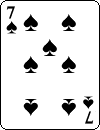


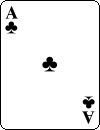
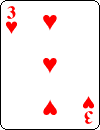
"There, all is well! It really doesn't matter how many credit or debit cards one has, as long as the combined interest rates add up correctly. I've heard that under the new rules, nobody will ever need more than six cards, three debit and three credit, but I'm not sure I believe that."
If the selected card is red, you'll probably want to explain first that this has negative value, and hence is really a debit card, before proceeding accordingly. (But read on for an alternative presentational possibility that works about half of the time in this case.)
Decidable Trit Tot
The first words from the mouth (or indeed keyboard) of a mathemagician should always be taken with a grain of salt, as they are often designed to distract attention from what is really going on, and take advantage of the trust generally accorded to mathematicians. It should come as no surprise above that once again the deck is not quite as shuffled as is claimed: the top three and bottom three cards are set up in advance and kept there through several riffle shuffles which genuinely mix (most of) the remainder of the deck. These six cards and their exact placements must be memorized in advance; it's also possible to start with all of them at one end or other of the deck, though harder to extract and keep track of them as needed later.
The mathematical fact we are exploiting here is the balanced ternary expansion:
Every non-zero whole number has an essentially unique representation
as a sum of signed distinct powers of 3, not counting cancellations.
For example, 10 = 9 + 1, 7 = 9 - 3 + 1, and - 5 = - 9 + 3 + 1. While it's also true that 10 = 9 + 1 + 3 - 3, we can handle this.
It's very convenient for card lovers that the numbers which can be represented using just -1, -3, -9, 1, 3 and 9 are precisely the numbers between -13 and 13. Following the convention that red cards represent negative values, the value of any card from a red King to Ace to a black Ace to King (wen kced redro enoyna?) can be represented with the six discernable cards here:
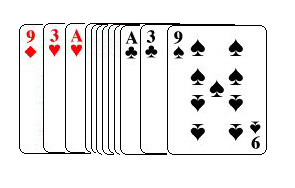
This is what the deck would look like fanned so that only the bottom and top cards would be visible; in practice you want to fan the cards so that these ones are not obvious! We recommend that the red 9, 3 and Ace be stashed at the top of the deck, in that order, and likewise the black Ace, 3 and 9 should be stashed at the bottom, so that the 9s are the top and bottom cards overall. As the cards near the face of the deck might make a visual impression on your audience when fanned, we recommend not fanning them too widely, and it might be a good idea to add a red royal card at the very (visible) bottom. Once the cards are out of sight, this decoy can be removed and plunged into the middle of the deck; that way it won't confuse you when you have to "make withdrawals" later.
Make sure that you practice reaching in and quickly extricating several of the cards displayed above.
The mathematics guarantees that any card selected can be matched in value. While we've proposed that red cards have negative values—and this is unavoidable when additions and subtractions are required—if the selected card is a red Ace, 3, 4, 9, 10, Queen or King, you may wish to simply match it by adding the values of some of the displayed red cards above.
One's patter must be adapted on the fly to deal with whatever suit the selected card is; sometimes it will be advisable not to dwell too much on the suit at all!
There are other cards that may be used if you worry that the powers of three used above are "too obvious." For instance, all numbers between -13 and 13 can also be represented using just -9, -3, -1, 2, 3, 8. Hence, the following cards could be the ones stacked at both ends of the deck at the outset:

However, with these values, sometimes four cards are needed to match certain interest rates, such as 6 = 8 + 2 - 1 -3, and uniqueness no longer holds, since, e.g., 5 = 2 + 3 = 8 - 3. (One could cheat, and first place all cards with such troublesome values close to the ends of the deck, thereby reducing the chances that any of them will be the chosen card, but that takes us further far from the spirit of mathematically based effects.)
The powers of 3 values effect above is a balanced ternary twist on an old binary classic which appears as "Findley's Four Card Trick" on pages 6-7 of Martin Gardner's Mathematics, Magic and Mystery (Dover, 1956), as mentioned in February 2008 Card Colm. We finish with a twist on the main effect in that column from two years ago, which may be worth considering as an alternative to the current column's first effect. Do not, however, try both on the same audience.
Oddly Accurate Orisons
Shuffle a deck several times and then deal five or six cards to the table, face down. Address one spectator, saying, "Let's perform a little experiment here. No doubt you've heard about the credit card reforms that kicked in recently. A little known aspect of those a novel way to compute your credit rating, which is based on simply consolidating all of your cards. Of course, debit cards really have negative interest rates; and they too must be counted, in their own way."
Have the cards on the table mixed up. Ask the spectator to select two or three of the cards, without seeing their faces, and without telling you how many are chosen, saying, "I'm going to avert my eyes and say a little prayer to Plutus, the Greek god of credit, that you chose wisely." Then turn away while the selections are made. Request that the selected cards be held so that you can't see them, and have the unused cards be stuffed into the rest of the deck, which is then set aside. Now turn back.
"You have selected several cards at random. I have no idea which ones, or even how many. Actually the cards you selected are probably a mixture of debit and credit cards. Each one has an interest rate. Don't look just yet, but you can tell whether it's debit or credit by checking if it's red or black. Of course, it's very important to know the difference! For instance, a red Queen is a debit card with twelve percent interest, whereas a black five is a credit card with five percent interest."
"Now when I turn away again in a moment, I'd like you to look at your cards, and add up their interest rates, then just tell me the total. Basically, you are going to consolidate all of your cards into just one card, and the overall rate in the new kind of credit rating, which I want you to tell me. Remember, debit cards have negative interest rates. For instance, if you have a red Ace and a red four, which are debit cards at one and four percent respectively, and a black Jack, that is to say a credit card at eleven percent, that's minus one minus four plus eleven, hence overall a six percent interest credit card, if you were to consolidate all of your cards. Are you ready? I'm going to offer up another little prayer that this all works out." Turn away once more.
Suppose that an overall rate of five percent is announced once the spectator has looked at, and again hidden, his cards. Turn back one last time, and continue. "They say you can tell a lot about a man from simply knowing his credit rating. I can tell a lot about you. You've revealed that came up with five percent when you consolidated your cards. In that case, having just attempted to communicate with the credit god, I'd say you have two credit cards and one debit card. Am I right?" That should get some reaction. But, wait, there is more.
"Actually, if I were a betting man, I'd say your debit cards have rates of one and three percent, respectively, and your credit card has a rate of nine percent. How did I do?"
At this point the spectator will likely move to reveal the cards he is holding. You may wish to add quickly, "That's because the cards you selected at random were in fact the Ace and three of Hearts, and the nine of Spades. Please show everyone your cards." Bow to thunderous applause.
For this effect, the six key cards must start at the top of the deck, and stay there through some shuffles you casually do. One thing to worry about is the possibility that two of the cards cancel each other out, as there is no way to tell which identical powers of 3—one red, one black—are involved. If the consolidated rate is (plus or minus) a power of three, you can side-step this by commenting, "You have three cards, but I believe that two of them cancel each other out, so let's focus on the one that remains." However, if a consolidated rate of zero is reported, you have less to work with; for this reason you may wish to insist that three cards be taken in the first place.
Basic Indebted Drift
In the February 2008 Card Colm on Additional Certainties, similar tricks to those above were done using a different mathematical principle, namely Fibonacci numbers. The six cards below were used, where each card had a positive numerical value:


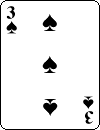

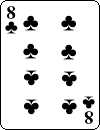
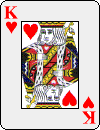
It's a pleasant surprise to learn that if the red cards above are interpreted as having negative values, i.e., as representing debit cards, then the consolidating credit card trick still works for two freely selected cards from these six. (Can the reader think of a reason why this must be so without checking the details?) In fact, when any two numbers are chosen from 1, -2, 3, -5, 8 and -13, we obtain the distinct sums: -18, -15, -12, -10, -7, -5, -4, -2, -1, 1, 3, 4, 6, 9, 11. Note that in most cases it suffices to know the absolute value of the sum to deduce the summands. If we switch red and black—changing suits to match, natch—we are still in luck.
The same holds for the "alternating Lucas" numbers 1, -3, 4, -7, 11 and the alternating version of the numbers 1, 2, 4, 6, 10 considered in the February 2008 Card Colm. However, we cannot modify 1, 2, 5, 7, 13 in this way, since 1 + 5 = -7 + 13.
"Tighter ascertainments" is an anagram of "matching interest rates," "decidable trit tot" is an anagram of "debit/credit total," and "oddly accurate orisons" is an anagram of "consolidate your cards." Likewise, "basic indebted drift" is an anagram of "debit and credit fibs (as is "drabbest if indicted"). Until now, we kept "We rig ternary conduit" under wraps—it's an anagram of "your new credit rating."




